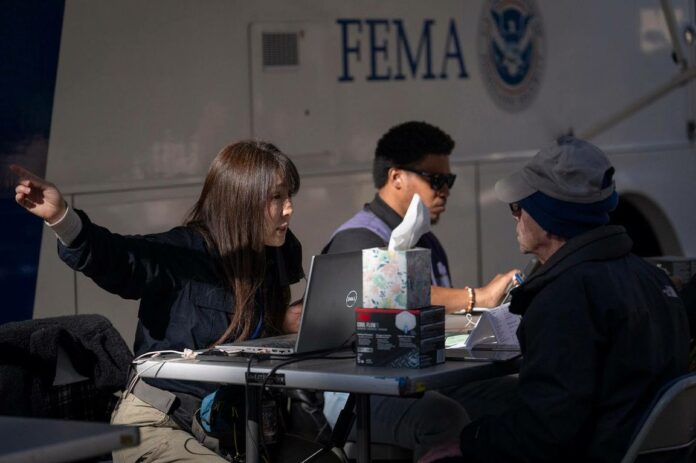Key takeaways
- Nearly 50,000 Asian Americans reside within the Los Angeles County evacuation zones during the January 2025 wildfires, with over 12,000 needing language assistance due to limited English proficiency.
- In the evacuation zones, the most commonly spoken Asian languages are Chinese, Korean, Tagalog and Vietnamese, but dozens of other Asian languages, which vary by evacuation zone, are also represented.
- Older Asian Americans experience significantly higher rates of limited English proficiency (61%) compared with younger generations (15%), making it more difficult to navigate emergency response and recovery.
Effective communication can be a challenge during and in the aftermath of any disaster, but as the recent wildfires pushed the limits of Los Angeles County, the gap caused by language barriers puts some populations at even greater risk.
Nearly 50,000 Asian Americans resided in the evacuation zone areas, with over 12,000 of them needing language assistance, according to a new data brief by UCLA researchers and AAPI Equity Alliance. The authors found that the diversity of the dozens of languages calls for targeted, multilingual emergency preparedness, response and recovery strategies that go beyond a one-size-fits-all approach.
“Knowing the language needs of Asian Americans ensures that they have access to life-saving information and that any efforts foster an inclusive disaster response,” said Paul Ong, research professor and director of the UCLA Center for Neighborhood Knowledge.
These language needs are part of a broader challenge in Los Angeles County, where over half a million of the more than 1.4 million Asian American residents are classified as having limited English proficiency, or LEP, which the U.S. Census Bureau defines as the ability to speak, read, write or understand English less than “very well.”
Language assistance needs vary among Asian American communities
LEP rates for those whom English is often a second language can vary widely across Asian American ethnic groups. Several groups have significantly higher rates — the highest being Vietnamese, Chinese and Korean Americans with each exceeding 45%, far greater than the county average of 36% among all Asians.
The brief also finds that older Asian Americans face substantially higher rates of LEP at 61% among those 65 and older, compared with younger generations at 15% for those aged 5 to 24. This disparity is largely driven by generational differences, as younger Asian Americans are more likely to be U.S.-born and receive education in the United States.
“Language accessibility for older generations is especially important,” said Melany De La Cruz-Viesca, deputy director of the UCLA Asian American Studies Center. “Often disaster recovery program descriptions rely on jargon, while the services can be too complicated to understand and use. This can make these groups also susceptible to scams.”
Dozens of languages are represented in the L.A. wildfire evacuation zones
When examining the evacuation zones from the Eaton, Palisades, Hurst and Hughes fires, 26% of the combined total Asian population in those areas had limited English proficiency. The researchers found that the Palisades has the highest proportion at almost 30%, while the Eaton zone has over a quarter of its Asian residents classified as LEP.
The Eaton evacuation zone had the largest share of Asian Americans impacted by the fires, with nearly 39,000 individuals, comprising approximately one-fifth (18%) of the area’s residents.
The most commonly spoken Asian languages in the combined evacuation zones are Chinese, Korean, Tagalog and Vietnamese. However, dozens of other Asian languages are also represented and vary by evacuation zone, which points to the broad range of language needs in these communities.
“Asian Americans have been overlooked by efforts for emergency preparedness, putting at risk our community who are already most vulnerable,” AAPI Equity Alliance executive director Manjusha Kulkarni said. “Government emergency response plans must prioritize communities with language needs and partnerships with grassroots organizations. Together, we can better prepare and protect hard-to-reach communities.”
Steps to enhance multilingual communication and improve accessibility
The researchers emphasized that the crisis caused by the wildfires presents an opportunity for advocates and decision-makers to rethink and strengthen emergency response strategies in order to build a more inclusive and equitable framework for disaster response. The data brief highlights several key recommendations:
- Identify language needs – Regularly assess language assistance needs in fire evacuation zones using census, school and community survey data. Partner with researchers with expertise in Asian American communities to conduct detailed analyses and anticipate language barriers before disasters occur.
- Provide culturally and linguistically appropriate communication – Develop in-language emergency materials tailored to the specific linguistic needs of affected communities.
- Strengthen partnerships with community organizations – Collaborate with trusted, community-based organizations that serve limited-English proficient populations to improve outreach and response.
- Community oversight and engagement – Create citizen oversight groups and facilitate local discussions, utilizing Asian language translators, to address barriers in disaster recovery and rebuilding.
- Institutionalize long-term improvements – Implement multilingual alert systems and integrate language access planning into broader emergency response frameworks.
According to the authors, data-informed and intentional action from government agencies, emergency responders and community organizations is needed to ensure that all residents — regardless of language ability — are fully included in recovery and rebuilding efforts.
The report is part of a series from the Center for Neighborhood Knowledge, in partnership with other research units at UCLA, including the Asian American Studies Center and the Latino Policy and Politics Institute, that examine the wide range of impacts of the January wildfires on Los Angeles communities, paying particular attention to different racial and ethnic groups.

